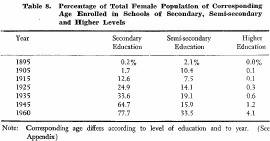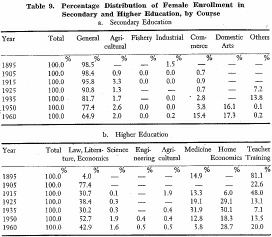| Home > Policy > White Paper, Notice, Announcement > White Paper > JAPAN'S GROWTH AND EDUCATION 1963 > CHAPTER |
||
The expansion of education during the early years of the modernization of Japan brought extended opportunity for both general culture and vocational and other specialized training not only to the males but also to the females whose education previously had been restricted to the home. This had significant effects in the subsequent socio-conomic developments in Japan.
The percentage of the total female population of Japan of elementary school age actually enrolled in elementary schools was 18.6 per cent in 1875. Twenty-five years later, in 1900, it exceeded 90 per cent. The significance of this fact lies in the great contribution to the development of the social foundation for the modernization of Japan.
Table 8 shows for the period 1895-1960 the percentages of the total female population of Japan enrolled in educational institutions of secondary, semi-secondary and higher level.

The foregoing table shows that the percentage of women enrolled
in secondary schools increased rapidly and continuously throughout the entire
period. Higher education for women started about the beginning of this century
but developed markedly only after World War ![]() .
In 1960, the percentage of females of higher education age actually enrolled
in higher institutions was only 4 per cent, as compared with 16 per cent in the
case of males.
.
In 1960, the percentage of females of higher education age actually enrolled
in higher institutions was only 4 per cent, as compared with 16 per cent in the
case of males.
The percentage distribution of female students in institutions of secondary and higher education is shown in Table 9 by major field of study for the period l895~1960.

At the secondary level the highest percentage of women have
been enrolled in the general courses. During the years, however, the number of
fields of study has increased and the vocational courses were greatly expanded
after the war when increasing number of women were emp1o3red. Among the semi-secondary
schools, miscellaneous schools giving specialized education such as dressmaking
and cooking, useful to daily life, increased greatly after World War ![]() .
.
At the higher education level the highest percentage of female students has been in the literature course. Other most popular courses for women have been nursing, home economics and education.
Since large percentages of women remain in the home rather than entering employment on leaving school, the percentage of the female graduates participating in labour force may be considered as a question when education is seen as an investment. Generally speaking, however, women with high educational background tend to become rational consumers and to give their children better education, so that there is no denying that they contribute to socio-economic development.
| Back to Top | MEXT HOME |